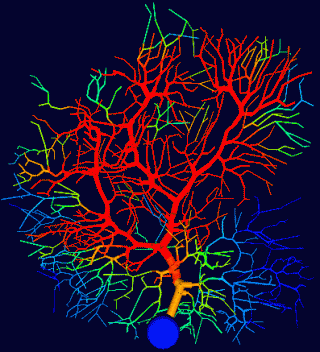Neuroscience
Neuroscientists Discover How Practice Makes Perfect
The cerebellum perfects skills by correcting unexpected errors.
Posted March 30, 2014

Purkinje Cell in Technicolor
Researchers at the University of Pennsylvania and Princeton University have made a breakthrough discovery that explains how the muscle-controlling neurons of the brain master skills through practice.
The research was conducted by Javier Medina, assistant professor in the Department of Psychology in Penn's School of Arts and Sciences, and Farzaneh Najafi, a graduate student in the Department of Biology. They collaborated with postdoctoral fellow Andrea Giovannucci and associate professor Samuel S. H. Wang of Princeton University.
The study titled, “Sensory-Driven Enhancement of Calcium Signals in Individual Purkinje Cell Dendrites of Awake Mice” was published in the February 2014 journal Cell Reports.
Purkinje Cells in the Cerebellum Create Muscle Memory
The cerebellum (Latin for “little brain”) is the brain's primary motor control center. It contains thousands of Purkinje cells which receive messages from a climbing fiber, which is a type of neuron that extends from the brainstem and sends feedback from every muscle throughout your body. In order to perfect motor skills, the brain has a feedback system that monitors when movements go right, and when movements go wrong.
Purkinje cells are the neurons that coordinate all the movements of the body. Climbing fibers are the neurons that provide feedback when there is an error or unexpected sensation. Together Purkinje cells and climbing fibers work in harmony to fine-tune motor control.

The Fabric of Mind by Richard Bergland
When I published The Athlete’s Way (St. Martin's Press) in 2007 neuroscientists were still unsure exactly how the brain created muscle memory. Luckily, my father who was a neuroscientist and neurosurgeon and wrote a book titled The Fabric of Mind (Viking) had long believed that the Purkinje cells of the cerebellum were the key to mastering a skill through practice. Because of this, I put Purkinje cells and the cerebellum in the spotlight as the key to The Athlete’s Way. (For more on this click here.)
When I was growing up, my dad would coach me at tennis saying, "Think about hammering and forging the muscle memory of your cerebellum with every stroke." These new discoveries help explain exactly how that process works.
The cerebellum is only 10 percent of brain volume but houses over 50 percent of the brain’s total neurons. My dad always said, “Whatever the cerebellum is doing, it’s doing a lot of it.” I trusted what he called "an educated guess" that the cerebellum was just as important as the cerebrum when I created the "up brain-down brain" split-brain model for The Athlete's Way.
A decade since I originally wrote the manuscript for The Athlete’s Way—after shaping the neuroscience ideas through daily conversations with my father—it’s exciting to see cutting edge neuroscience confirm my dad's hunches. Although my father passed away in 2007, I know these new findings about Purkinje cells and climbing fibers would put him over the moon.

Original Purkinje sketch by Santiago Ramon y Cajal
For decades, the enigma of how the feedback system between climbing fibers and Purkinje cells work together has perplexed neuroscientists. In this breakthrough study, the Penn team has shown for the first time that there is a measurable difference between "true" and "false" signals. This knowledge will greatly advance future studies of fine motor control, particularly with regard to how movements can be improved with practice.
This discovery gives new and specific evidence to the mechanisms of cerebellar neuroplasticity. The fact that new neural pathways become hard-wired in response to error signals from the climbing fibers allows the cerebellum to send better instructions to motor neurons the next time the same action is attempted. This is why you never forget how to ride a bike.
Conclusion: Purkinje Cells, Climbing Fibers, and the Cerebellum Remain Mysterious
The exact mechanism that allows individual Purkinje cells to differentiate between the two kinds of climbing fiber signals remains an open question and more research is needed. Knowing that Purkinje cells are able to distinguish when their corresponding muscle neurons encounter an error will probably change future studies of fine motor control. Hopefully, this new discovery from Penn scientists will lead to new research into the fundamentals of neuroplasticity and ways to improve the mastery of any skill through practice, practice, practice.
If you'd like to read more on the cerebellum and Purkinje cells, check out my Psychology Today blog posts:
- "No. 1 Reason Practice Makes Perfect"
- "Toward a New Split-Brain Model: Up Brain-Down Brain"
- "How Is the Cerebellum Linked to Autism Spectrum Disorders?"
- “Childhood Family Problems Can Stunt Brain Development”
- "The Neuroscience of Calming a Baby"
- “Why Is Dancing So Good For Your Brain?”
- “The Neuroscience of Madonna’s Enduring Success”
- "Gesturing Engages All Four Brain Hemispheres"
- "The Neuroscience of Superfluidity"
- "One More Reason to Unplug Your Television"
- "Better Motor Skills Linked to Higher Academic Scores"
- "The Neuroscience of Imagination"
- "Too Much Crystallized Knowledge Lowers Fluid Intelligence"
Follow me on Twitter @ckbergland for updates on The Athlete’s Way blog posts.




